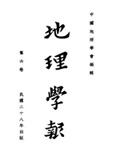Mei-Ngo Jen, S.P.Chen, L.P.Yang, Y.F.Shih, S.C.Chiao
In an agricultural country like China, with 3/4 of her people tilling soil for their living, land forms the principal source of the nation's wealth. The improvement of the living standard and indeed, the recon.st-ruction of the country at large, must depend on a thorough under-stan-dig of the present conditions of land utilization so that meaures may be taken for rational use of natural resources. Unfortunately, accurate information of this sort is almost lacking. Prof. Buck's authorative work (1}, while giving us a splendid sketch of land utilization in China, is not sufficiently accurate in detail owing to the fact that his data are chiefly collected by agricultural reporters in various localities. In motEnta}nous ragion.s woich cover nearly 3/4 of the total area of China(2),the land use presents such a great diversity between valley plains and slopes that without detailed field work, report of land utilizat.on from a given loca-lty, if taken as representing the whole area, is apt to be misleading.
